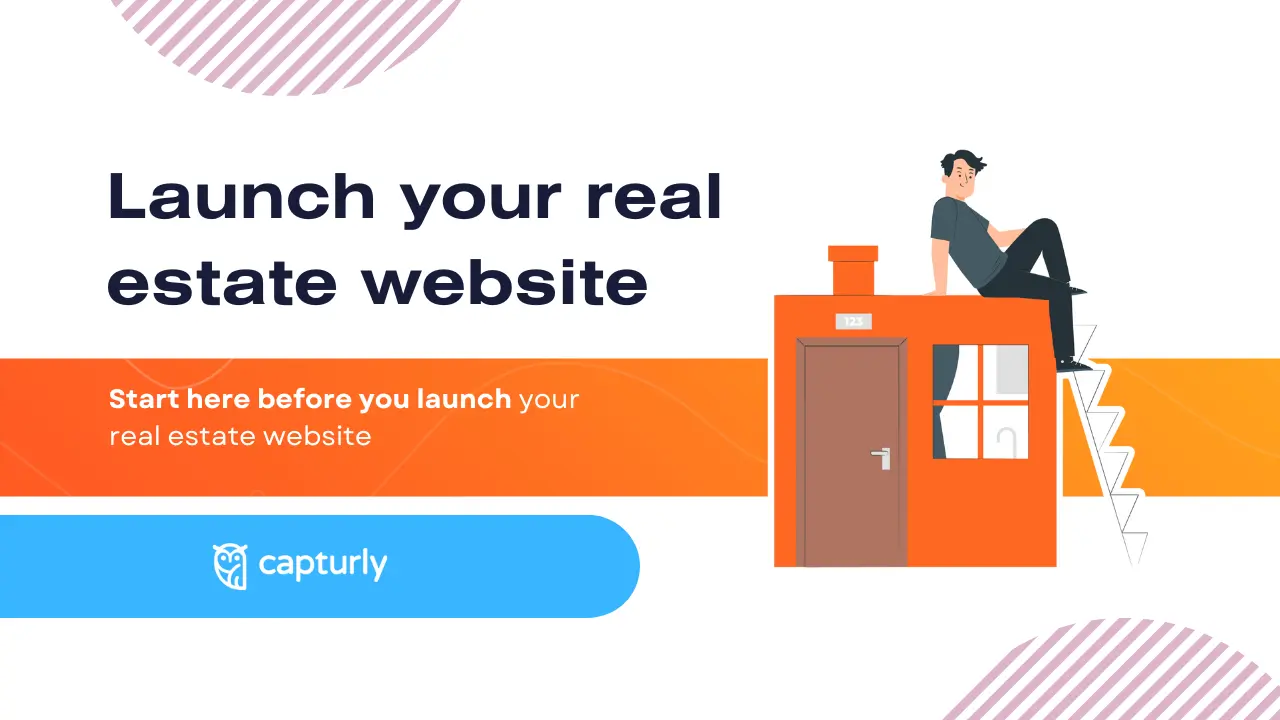According to Webfx, there are currently 1,09 billion websites in the world. Based on the current population of the world that means that there’s a website for every eight people. That may indicate that we no longer need new and new websites. That’s already too much! But we can’t make a bigger mistake than thinking that, since we need to take an in-depth look at the world of websites.
Many of these websites are non-functional, as they didn’t renew the domain, or there is no SSL certification and the browser doesn’t let the customers enter the site. Some of these websites are also outdated. These don’t contain a single call-to-action, video, or just the content irrelevant today. And last but not least: most of these websites are ghost websites! Nobody uses them! So you always have your chance to create something unique, grab attention, and attract your potential buyers’ eyes!
Luckily, that is more specifically true in the case of real estate websites. Don’t get me wrong, big fishes, like Zillow have almost 20 years of history online, and slowly built up their market leader position in the United States. However, according to Statista, the real estate market’s value has increased in recent years, so the market need is bigger than ever. On top of that, these potential buyers have new and new attributes, and they expect different features from real estate websites, than the first online visitors in 2006.
If you know who you want to grab with your real estate website and build up your website based on this group’s needs, your website can be a real deal after just a few months. In this article, we help you with that! We introduce you to the steps that are essential to do, before launching a real estate website. A real estate website that has serious potential in this concentrated market!
Table of Contents
1. Define your goal
First, you need to define the most important things:
What do you want to do on your website?
The existential purposes of real-estate websites are quite different. Some businesses use this as a place, where the target audience can buy, or rent real estate. Other businesses use the website as a “product recommendation”. In this case, these brands only showcase the properties, but there’s no “buy online” function. Here, you need to physically get in touch with the company to get the desired property.
Some of the businesses work in a reverse way. Here, the website exists to get more information about the desired real estate that the potential buyer already examined.
So, it’s your task to analyze what you really need, and which option is compatible with your current business structure.
Who is your target audience?
You can’t sell anybody at once. That’s crystal clear; you need to make choices on choosing the name, the color of your website, or the font style. Even if these choices are not equally important, these all – directly, or indirectly – influence the buyers’ decisions.
Since decisions that put people into different groups show up in the early stages of your website creation, it’s better to define your target audience in the first place. If you have already established a target audience in the past years of offline work, you better rely on that segment online too. If not, you need to do some research, which we will discuss in the next chapter.
Based on the general knowledge in marketing, you shouldn’t define more than 5 target audiences, and make easily distinguishable differences between them.
For example:
“A” target audience: Home buyers
This group of people want to buy homes and need guidance in the buying process, and the financing options. This target audience doesn’t want to buy properties for a later reselling option, this group wants to have a home for the next 10 years.
“B” target audience: Home sellers
These individuals want to sell their homes, but have no clue on how to start that. They want to get further help from your real estate consultants about the best time to sell, current market trends, and maximizing return on investment.
After that, you can even make real estate buyer personas! Please check this article, if you want more information about them!
2. Do some research!
Well, it’s good if you have an idea. But it’s better to do some research before spending too much on the site. You need to get answers to numerous things.
First of all: is your potential target audience really gonna use your site? If your potential online target audience matches your current offline ones, just send them surveys, and evaluate the results. If most of them point out that a website would be beneficial for them, it’s better to move forward to the next step.
Although, in some cases, your potential target audience is nothing more than a pre-made calculation. You have no contact with this group, and you have no past data about their preferences. Well, in a situation like this, you still have to somehow get information about them. Social media advertised questionnaires will be your best friend in this activity, to fully discover the group. Of course, social media questionnaire research will never be representative, (you can’t completely point out your target group’s preferences from the respondent’s answer) but it still tells you some clues.
But you can’t stop here. Even if your intuition is right, and your target audience really wants a website from you, there’s one problem. You still don’t know, for what purpose would they really use it. An online questionnaire may give you some answers on this topic as well. The respondents can write down the potential task they would be happy to solve with your site.
So, even if they already use a site to get notifications about the latest trends, and cheap households, they are searching for a site where they can go through the procedure. To find cheap real estate, and buy it. In this case, you shouldn’t invest money in establishing a quick notification system and hiring two copywriters. Instead, you need to spend more money on establishing a secure place, where people can happily buy houses.
3. Choose the name, and the domain
After you get a positive response, and you know the submarket that you will cover, now you can start thinking of your name and the domain.
Even if choosing the right name sounds like an easy challenge, there are a lot of factors to consider. We will sort these considerations into three groups.
Brand alignments
- It’s important to find a name that fits your target audience. You don’t have too much space to play in terms of website names, but even one/two word(s) can matter.
- Keep it simple! For SEO purposes, it’s not the best strategy to write a page-long name to your website. Simultaneously be expressive, and short.
- Also for SEO purposes, try to use one of the most popular keywords in your industry in your name. So if you discover that in the real estate industry “property” is a high-searched word, include it in your name.
Practical tips
- In this case, your name is basically equal to your domain name. However, to avoid domain duplication, it is impossible to have websites under the same domain. That’s why, even if you find the perfect name for you, you need to check whether it is used, or not. Luckily, numerous sites exist to check domain availability. On the other hand, ChatGPT can help you find other alternatives, if your ideas were all reserved.
- You can also play with your domain extension. That’s what comes after your name. In the case of “Zillow.com”, .com is the domain extension. We won’t want to bore you with its technical stuff, but there are many domain extensions to choose from. There are more expensive ones but with better visibility, and vice versa. As a brand, a special domain extension can even highlight you from the market, so we advise you to get more information about this topic. And find the best one for your expectations.
Future considerations
- Do not be restricted to the present, and plan for the future. We suggest that even if you take part in only a small percentage of the possible real estate website functionalities, don’t highlight that in your name. Maybe later you want to focus on other parts, but the name will limit you on your current state.
- Avoid giving similar names to your website than the current ones have. Till your website is small, the big fishes don’t care about your earned clients and progress. But, as you grow bigger, and more eyes on you, lawyers can easily enter the stage. Be creative, and do not want to climb on the back of popular real estate websites, as it won’t be a successful strategy in the long term.
4. Find the best website builder for your needs
First, we need to understand the real meaning of a website builder. A website builder basically helps you create, and design a website without (almost) any code-writing skills. These tools can both replace the programmers, and the designers, and you can create simple but effective pages, with an easy-to-learn (usually drag and drop) technique.
According to Mycodelesswebsite, the monthly prices of website builders are far cheaper than appointing professional web developers for the same challenges.
However, there are numerous website builder tools across the internet. What do I choose? What does a perfect real estate website builder look like? – Many of you may have already asked this question. Well, there are many major factors that can influence your decision.
5. Pros and cons of the best website builder sites
In this subchapter, you will meet with the most popular website builder tools, their strengths, and weaknesses.
Wix
Wix is probably the most in-depth website builder in the market currently. This tool offers several options to choose from, it’s easy to understand its working mechanism, and there is a free plan. However, the free plan has a lot of limitations, and after you get upgraded, you won’t thank it: it would cost you between $17 to $159 for a month.

Squarespace
Squarespace is a little bit cheaper than Wix and has an even more easy-to-learn interface. And even if it doesn’t contain the same number of customizable options as Wix, it won’t disappoint you either. However, you always need to manually save your changes, which seems a little frustrating sometimes. On top of that, there’s no free plan to discover the power of the main features.

Shopify
Shopify is usually chosen by E-Commerce websites, with large inventories. It’s neither that cheap, and not a preferable choice for real estate websites, so we can move forward to other options.

WordPress
WordPress.com, the leading website builder tool on the internet, is also one of the best weapons for starters, and beginners in website building. Most of the websites that were created by a website builder used this tool. Although it is free of charge and easy to handle, there are not too many customizable options. Unlike WordPress.org, which is the paid version of WordPress.

Hostinger
The last competitor that we introduce in this segment is Hostinger, which is famous for its numerous AI capabilities. If you want to try the most innovative website builder service, this should be your choice. On top of that, the paid prices start from $2.99, which is a bargain for the amount of customizable options this tool contains. However, it is not recommended to use for complex websites, as this tool misses out on some crucial functions to perfectly satisfy those sites’ needs.

6. Features you shouldn’t miss out!
Even if you always tailor your available features to your target audience’s needs, there are some must-have ones. Like, there are some functionalities that all real estate websites should include to enhance the user experience! In this part of the article, we will share some effective features of a real estate website!
Detailed filtering capabilities
When visitors want to look for houses, they all have some preferences. The type of home they want (house, apartment, condo), the maximum dollars they can pay, or a square feet range which will be enough to live there comfortably. If you can’t include these filtering options, potential buyers need to sort out the offers one by one, which is too much effort for them.
And what’s the consequence of too much effort? It generates a bad user experience. And studies show that around 88% of online buyers wouldn’t return to a website, after having a bad user experience.
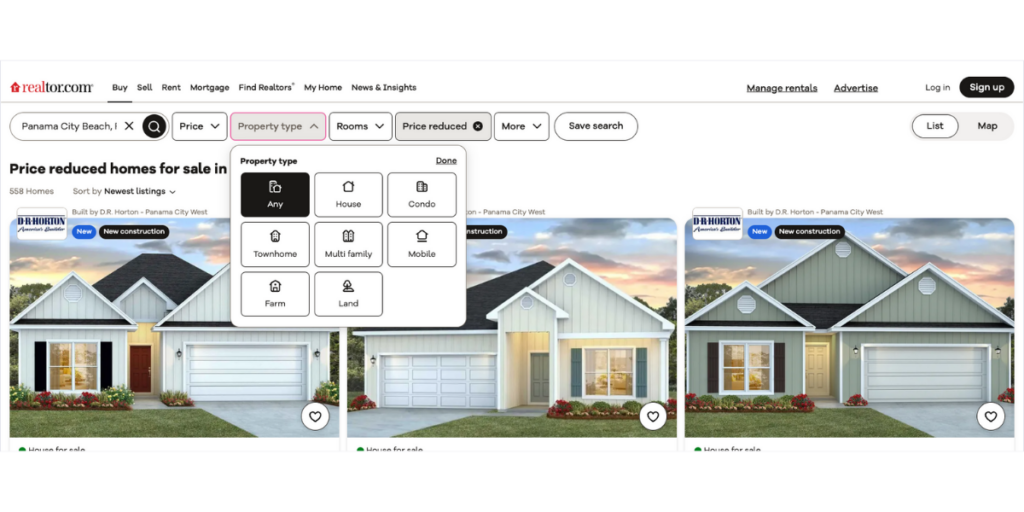
That’s Realtor’s filtering options, one of the leading real estate websites in the United States. As you can see, they offer so many searching capabilities to their potential buyers to make their task easier, and to enhance their user experience. This behavior definitely affects their revenue positively.
Interactive maps
When you launch your real estate website, you better make an interactive map, as well. The main purpose of this feature is to display where your offered houses are exactly. Interactive means in this case that the visitors can click on the red dots in the map (which indicates your listings), and the potential buyer gets to know all the information about the clicked real estate.
Let’s see Zillow’s version:

As you can see, this site uses a Google Maps integration to perfectly align the expectations. However, they place their listings inside the map, and the customer can browse the options comfortably, without opening new and new pages.
Neighborhood information
Boosting your site’s credibility is very important when you launch your real estate website. It’s very important to earn some loyal users, but a newly launched real estate website is not the most secure place in many of our eyes. That’s why giving out the listings’ neighborhood information is a mandatory task.
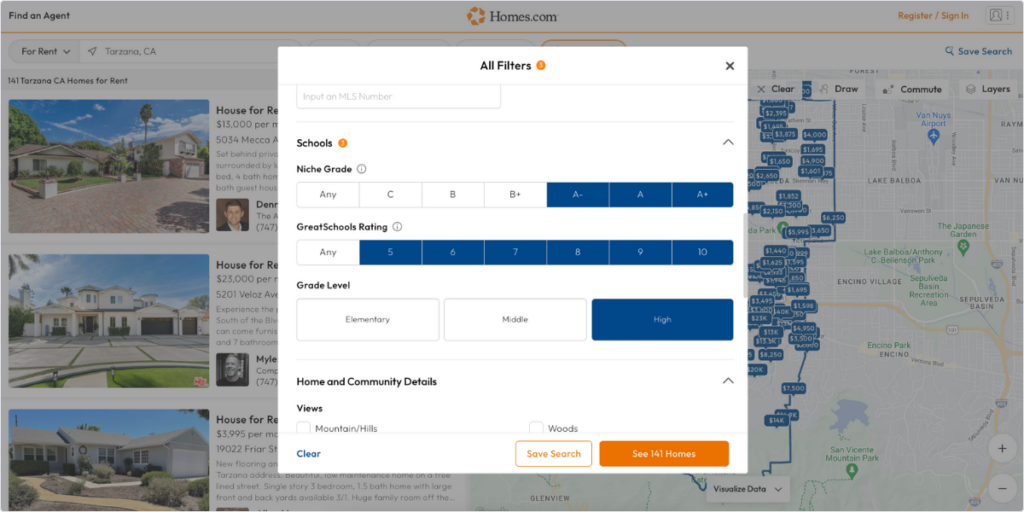
Homes realized the opportunity in this feature months ago and made a revolutionary update to their website. They solved this problem with a map which lists all the important activities, and buildings nearby that can influence the buying decision. Although you can write texts about the neighborhood as well, this solution is even more effective.
This can also be achievable with a Google Map integration, and provide so much crucial information to the potential buyers.
Virtual tours
This fourth option is rather a new opportunity than a must-have feature. However, research shows that 88% of visitors stay longer on a website that contains video elements. On top of that, when you are new to a market, you need to come up with innovative ideas to highlight the market and convince the visitors. Implementing virtual tours is a great option to improve on that.
“A virtual tour is a simulation of an existing location, usually composed of a sequence of videos, still images or 360-degree images.” The advantage of virtual tools in contrast to static images is that the visitor can observe every little aspect of the house. Here, they won’t think about “Why doesn’t the seller show the other side of the room?” – as in the case of a virtual tour they can examine every little segment of the house. They can rotate the picture, zoom in, or out when they see something; all of this with a simple Google Map integration.
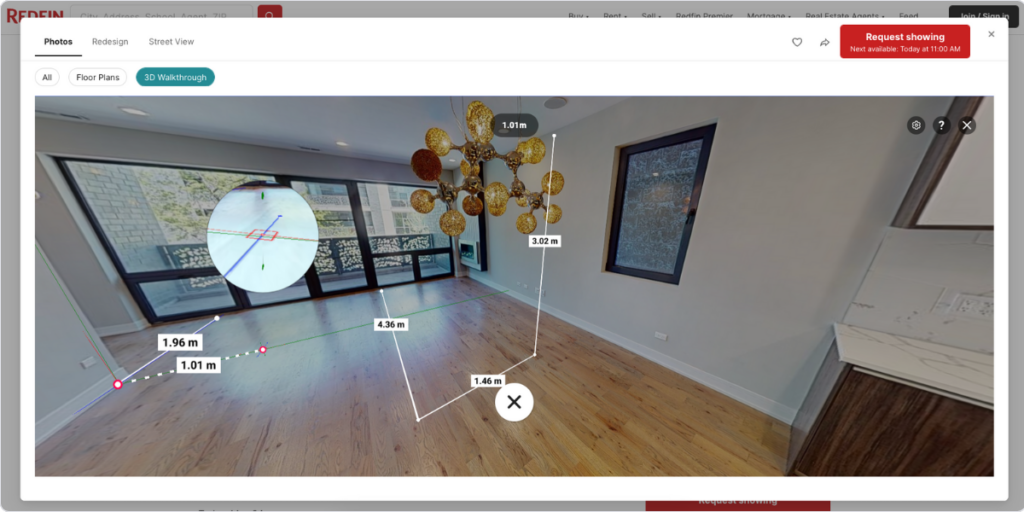
Establishing this feature not only increases your reliability but improves the average spent time on your site, so you can win two things at once!
7. Set some analytics tools
You are almost done by now, but you still have some tasks. Even if setting up analytics tools doesn’t seem to be a crucial task, the situation has changed in the last couple of years. Getting more information about your users is essential, because:
- You get notified about bugs and other problems
- Understand why they behave the way they do
- You get an answer to what stages they get bounced from your conversion funnel
- You can offer a personalized user experience
- You can make decisions based on proofs
For this reason, behavioral analytics tools appeared on the market to track the visitor’s movements on a given site and deliver insights to the companies.
There are two types of analytics tools. These are quantitative (which rather track measurable stats), and qualitative (which can’t be analyzed statistically) tools. You need both to have a complete picture of your user’s activities and behavior that are connected to your site.
Quantitative analysis
Google Analytics is one of the best options for quantitative analysis. This tool is free to use (certain functions), which we can’t tell about its competitors.
This tool analyzes your traffic, demonstrates some crucial aspects of your website’s demographics, and ensures some conversion metrics. With Google Analytics you get to know your number of page views, the ratio between new and returning visitors, or your conversion rate statistics. And there are hundreds of other functions, which all lead you to more successful decision-making.
However, Google Analytics can only track this information, if you added the tool to your site, even before you want to start measuring. So it’s essential to add Google Analytics to your site before you launch it!
Qualitative analysis
Now you are aware of what your visitors do on your website! However, you still have no clue about the real meaning of an activity. Let us demonstrate this through an example:
You have metrics that out of 100 users, 60 get bounced from your conversion funnel, when choosing the “request a tour” option. Google Analytics shows you the existence of this activity, but not the real meaning. That’s why qualitative tools exist, which answer the “why-s” to you.
Our tool, Capturly Analytics offers one of the most in-depth qualitative analyses across the internet. With our tool, you can track the visitors’ clicks, scrolls, individual sessions, and many more.
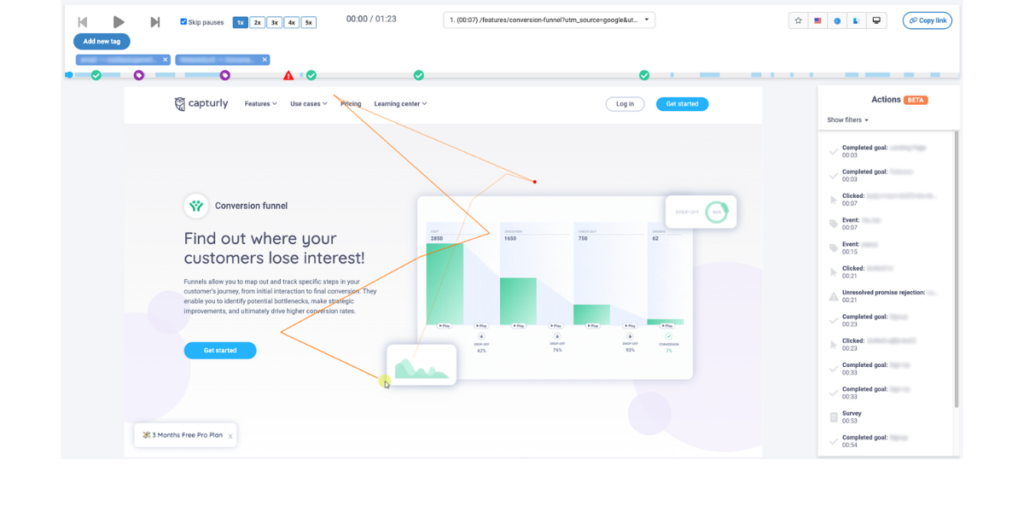
To end the previous example, our tool is capable of giving answers to an activity like this. After you watch 5 different sessions (with our session recording tool which is capable of showing real actions of visitors as they browse your website) you realize that when one of the visitors chooses the agent on one day, the program doesn’t let the other visitors to reserve the same agent at the same day, but for different time intervals. It’s basically a bug, and after you fix it, this 60% bounce rate drops down to 20%.
Capturly Analytics works better if you set it even before launching your real estate website. You don’t need to panic about its high fee either: our tool is completely free! However, if your site grows bigger, with higher traffic, we also offer paid packages to keep the tempo with the higher expectations!
8. Test everything and launch your real estate website!
In this last step, you only need to make some final preparations. The thing is, if you put effort into creating a professional site for your business, checking that everything works as it should is a must-have aspect.
Do not let those huge bugs spoil months of work, and burden your high expectations. That’s why you need to:
- Review your content for potential errors, misspells, or unauthorized information
- Optimize them for SEO opportunities
- Make back-ups, if something goes out of control
- Test your security provisions, and that you followed every instructions
- Test your performance – nobody likes a slow-loading website

After you tested all of the above facts, you can start the launching process. Here, our tip is the following: make a two-step launch, to get more information about potential mistakes, and elements that you need to reconsider. First, make a soft launch for a smaller user base, and then the full launch for your real estate website.
Conclusion
In this article, we shared the most important information about launching a real estate website from the beginning to the very end. If you follow our instructions, you will more easily navigate yourself through the hundreds of tasks that lead you to a complete website creation. You can even learn some complementary information from this article, which all help you to be unique in the market!
According to Statista, the real estate market is stronger than ever, and the projected revenues from this market are even going to increase in the next couple of years.
It ensures you remain competitive and relevant in a digital market, and it offers 24/7 accessibility to your brand!
The first step consists of two crucial elements: defining WHAT you will sell, and WHO will buy your products and services.
A website builder is essential for creating a professional, user-friendly real estate website quickly and cost-effectively, offering customizable templates, built-in SEO tools, and responsive design. It allows for easy setup and management, ensuring your site meets business needs and enhances your online presence.
If we add up the estimated time of the 8 steps, you can finish your work between 8 to 13 weeks. However, we recommend that you don’t take it in a hurry, and make the perfect choices at each step!
Don't forget, sharing is caring! :)

